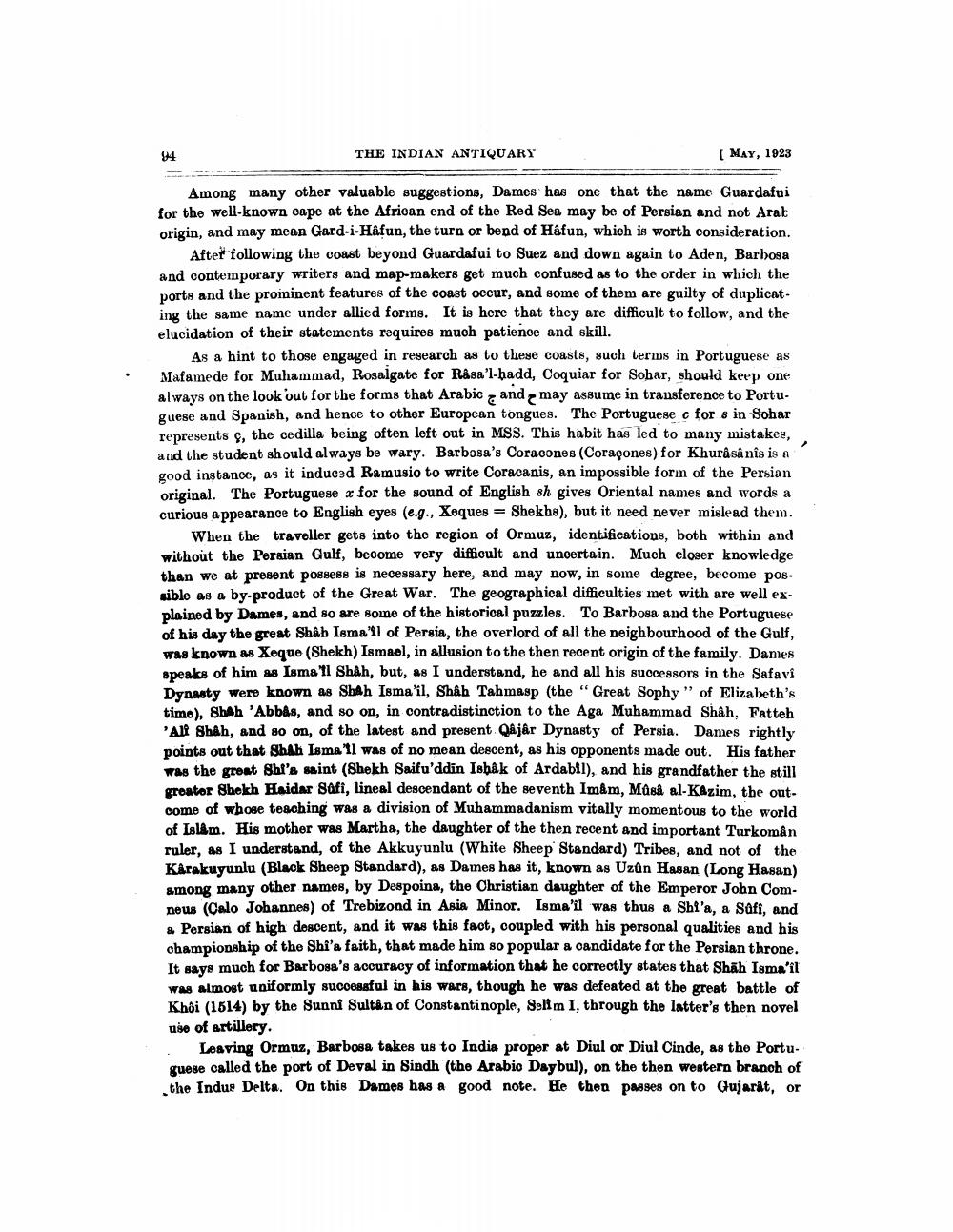________________
THE INDIAN ANTIQUARY
MAY, 1923
Among many other valuable suggestions, Dames has one that the name Guardafui for the well-known cape at the African end of the Red Sea may be of Persian and not Arab origin, and may mean Gard-i-Háfun, the turn or bend of Håfun, which is worth consideration.
After following the coast beyond Guardafui to Suez and down again to Aden, Barbosa and contemporary writers and map-makers get much confused as to the order in which the ports and the prominent features of the coast occur, and some of them are guilty of duplicating the same name under allied forms. It is here that they are difficult to follow, and the elucidation of their statements requires much patience and skill.
As a hint to those engaged in research as to these coasts, such terms in Portuguese as Mafamede for Muhammad, Rosalgate for Råsa'l-hadd, Coquiar for Sohar, should keep one always on the look out for the forms that Arabic and may assume in transference to Portuguese and Spanish, and hence to other European tongues. The Portuguese c for 8 in Sohar represents , the cedilla being often left out in MSS. This habit has led to many mistakes, and the student should always be wary. Barbosa's Coracones (Coraçones) for Khurasa nîs is a good instance, as it induced Ramusio to write Coracanis, an impossible form of the Persian original. The Portuguese x for the sound of English sh gives Oriental names and words a curious appearance to English eyes (e.g., Xeques = Shekhs), but it need never mislead them.
When the traveller gets into the region of Ormuz, identifications, both within and without the Persian Gulf, become very difficult and uncertain. Much closer knowledge than we at present possess is necessary here, and may now, in some degree, become posvible as a by-product of the Great War. The geographical difficulties met with are well ex. plained by Dames, and so are some of the historical puzzles. To Barbosa and the Portuguese of his day the great Shah Iema'll of Persia, the overlord of all the neighbourhood of the Gulf, was known as Xeque (Shekh) Ismael, in allusion to the then recent origin of the family. Dames speaks of him as Ismail Shah, but, as I understand, he and all his successors in the Safavi Dynasty were known as Shah Isma'il, Shah Tahmasp (the "Great Sophy" of Elizabeth's timo), Shah 'Abbas, and so on, in contradistinction to the Aga Muhammad Shah, Fatteh 'All Shah, and so on, of the latest and present Q&jâr Dynasty of Persia. Dames rightly points out that Shah Isma'll was of no mean descent, as his opponents made out. His father was the great Shi'a saint (Shekh Saifu'ddin Ishak of Ardabil), and his grandfather the still greator Sbokh Haidar Safi, lineal descendant of the seventh Imam, Maså al-Kazim, the out. come of whose teaching was a division of Muhammadanism vitally momentous to the world of Islam. His mother was Martha, the daughter of the then recent and important Turkomân ruler, as I understand, of the Akkuyunlu (White Sheep Standard) Tribes, and not of the Karakuyunlu (Black Sheep Standard), as Dames has it, known as Uzun Hasan (Long Hasan) among many other names, by Despoina, the Christian daughter of the Emperor John Comneus (Calo Johannes) of Trebizond in Asia Minor. Isma'il was thus a Shi'a, a Safi, and
Persian of high descent, and it was this fact, coupled with his personal qualities and his championship of the Shi'a faith, that made him so popular a candidate for the Persian throne. It says much for Barbosa's accuracy of information that he correctly states that Shāh Isma'il was almost uniformly successful in his wars, though he was defeated at the great battle of Khôi (1514) by the Sunni Sultan of Constantinople, Selim I, through the latter's then novel use of artillery.
Leaving Ormuz, Barbosa takes us to India proper at Diul or Diul Cinde, as the PortuQuelle called the port of Deval in Sindh (the Arabio Daybul), on the then western branch of the Indus Delta. On this Dames has a good note. He then passes on to Gujarat, or




